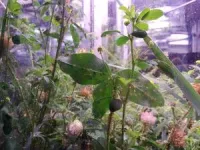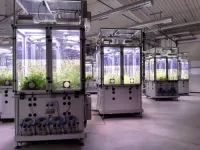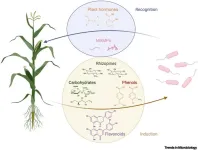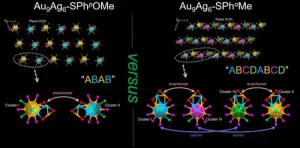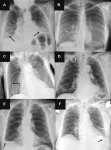(Press-News.org) Earthworms are important drivers of global food production, contributing to approximately 6.5% of grain yield and 2.3% of legumes produced worldwide each year, according to new work published by Colorado State University scientists in the journal Nature Communications.
These new estimates from a trio of CSU researchers mean earthworms may account for as much as 140 million metric tons of food produced annually — roughly comparative to the amount of cereal grains (rice, wheat, rye, oats, barley, maize and millet) grown annually by Russia, the world’s fourth-largest producer.
“This is the first effort that I’m aware of that’s trying to take one piece of soil biodiversity and say, ‘OK, this is the value of it; this is what it’s giving us on a global scale,’” said Steven Fonte, associate professor of agroecosystem ecology in the Department of Soil and Crop Sciences at CSU, and the study’s lead author.
Earthworms help establish healthy soils by supporting plant growth in multiple ways — building good soil structure, assisting in water capture and aiding in the beneficial churn of organic matter that makes nutrients more available to plants. Other research has also shown that earthworms can facilitate the production of plant-growth-promoting hormones and help plants protect themselves against common soil pathogens. Some estimates have indicated earthworms can increase overall plant productivity by about 25 percent.
Fonte and his colleagues — Nathan Mueller, an associate professor in the Department of Ecosystem Science and Sustainability, and Marian Hsieh, a doctoral student in the same department — estimated the contribution of earthworms to global food production by overlaying and analyzing maps of earthworm abundance, soil properties, fertilize rate and crop yields.
The analysis indicated that earthworms had a more significant impact on grain production in the global south — notably, 10% of grain yield in Sub-Saharan Africa and 8% in Latin America and the Caribbean. It’s likely the earthworms contributed more in those areas, Fonte said, because farmers there tend to have less access to fertilizer and pesticides. Instead, they rely more on earthworm-rich organic matter like manure and crop residues, which help stimulate the beneficial effect earthworms have on plants.
“Earthworms are contributing a lot in these areas where we have fewer chemical inputs,” Fonte said.
For this study, Fonte and his colleagues analyzed earthworm impacts on four grain crops: rice, maize, wheat and barley; the group examined a set of legumes that included soybeans, peas, chickpeas, lentils and alfalfa, among others.
Fonte said he thinks soil biodiversity has historically been undervalued, and that he hopes this work will bring more attention to how healthy soils can have positive, tangible impacts on crops.
“If we manage our soils in a more sustainable way, we can better harness or leverage this biodiversity and produce more sustainable agroecosystems,” Fonte said. “This work highlights that potential.”
Fonte noted that other recent research has shown that soils contain as much as half the world’s biodiversity, a significant increase from previous estimates of approximately 25%. “Soils are just such an intricate habitat,” he said. “But there’s really been very few efforts to understand what that biodiversity means to our global crop yields.”
Diana Wall, a professor in the Department of Biology and the science chair of the Global Soil Biodiversity Initiative, was excited by the data published in the Nature Communications paper. “This, to me, is a really clever, very data-rich paper,” Wall said. “It’s really impressive.”
This information could also have implications in future efforts to mitigate drought and erosion, Fonte said. For example, he said, earthworms can improve soil porosity, aiding in the beneficial capture and retention of water.
Fonte cautioned that he and his colleagues are not advocating for anyone to transplant earthworms into places they do not already exist. Rather, he hopes this work shows how improved management of soil biology in places where earthworms already call home has the potential to enhance agricultural productivity and reduce our reliance on agrochemicals. This study marks an important first step, Fonte said, but he hopes that researchers will continue to dig into the positive benefits that other soil organisms have on crops.
“Soils are still this huge, big black box that we don’t fully understand,” Fonte said. “This work helps show that there’s a lot of opportunity that we’re just kind of ignoring.”
He added, “There are probably other soil organisms that are even more important, especially microbial communities.”
Adapted in part from a Nature Communications news release.
END
Earthworms contribute to 6.5% of global grain production, according to new CSU research
2023-09-26
ELSE PRESS RELEASES FROM THIS DATE:
Invertebrate decline reduces natural pest control and decomposition of organic matter
2023-09-26
Leipzig. The decline in invertebrates also affects the functioning of ecosystems, including two critical ecosystem services: aboveground pest control and belowground decomposition of organic material, according to a new study published in Current Biology and led by researchers at the German Centre for Integrative Biodiversity Research (iDiv) and Leipzig University. The study provides evidence that loss of invertebrates leads to a reduction in important ecosystem services and to the decoupling of ecosystem processes, making immediate protection measures necessary.
Invertebrates, such as insects and also ...
Genetically engineering associations between plants and nitrogen-fixing microbes could lessen dependence on synthetic fertilizer
2023-09-26
Nitrogen is an essential nutrient for plant growth, but the overuse of synthetic nitrogen fertilizers in agriculture is not sustainable. In a review article publishing in the journal Trends in Microbiology on September 26, a team of bacteriologists and plant scientists discuss the possibility of using genetic engineering to facilitate mutualistic relationships between plants and nitrogen-fixing microbes called “diazotrophs.” These engineered associations would help crops acquire nitrogen from the air by mimicking the mutualisms between legumes and nitrogen-fixing bacteria.
“Engineering associative diazotrophs to provide nitrogen ...
Impact of parental relatedness on type 2 diabetes and other common diseases uncovered
2023-09-26
A new study finds that consanguinity – unions between close relatives - may increase the risk of common diseases such as type 2 diabetes and post-traumatic stress disorder (PTSD).
Researchers from the Wellcome Sanger Institute and their collaborators at Queen Mary University of London analysed the genomic data of diverse groups to investigate the relationship between autozygosity - a measure of genetic relatedness between an individual’s parents - and the prevalence of common diseases, with a novel method that reduces confounding due to sociocultural factors. They focused ...
Redefining global health security: A novel framework sheds light on equity and decolonial approaches
2023-09-26
Redefining Global Health Security: A Novel Framework Sheds Light on Equity and Decolonial Approaches
Kuala Lumpur, Malaysia and London, UK – 25 September 2023
In the wake of the COVID-19 pandemic, a new policy paper titled "Global Health Security and the Health-Security Nexus: Principles, Politics and Praxis" in the journal BMJ Global Health, warns of dangers and potential pitfalls associated with the increased attention paid to ‘global health security’ and the growing interaction between public health and security actors.
According to the authors, the prevailing ...
Inbreeding can be beneficial in the long run
2023-09-26
"Of all the subspecies of reindeer found in the high north, the Svalbard reindeer has the most inbreeding and the lowest genetic diversity," says Nicolas Dussex, a postdoc at Norwegian University of Science and Technology´s (NTNU) Department of Natural History.
It was only 7000-8000 years ago that the first reindeer migrated to Svalbard, most likely from Russia via Novaya Zemlya and the islands of Franz Josef Land. Perhaps there were no more than a few animals that established themselves on the arctic ...
Feds fund research that could slash US cancer deaths by 50%
2023-09-26
HOUSTON – (Sept. 26, 2023) – The Advanced Research Projects Agency for Health (ARPA-H) has awarded $45 million to rapidly develop sense-and-respond implant technology that could slash U.S. cancer-related deaths by more than 50%.
The award to a Rice University-led team of researchers from seven states will fast-track development and testing of a new approach to cancer treatment that aims to dramatically improve immunotherapy outcomes for patients with ovarian, pancreatic and other difficult-to-treat cancers.
“Instead of tethering patients to hospital beds, IV bags and external monitors, ...
Thiol ligands modify metal nanocluster structures and optical properties
2023-09-26
Metal nanoclusters are tiny, crystalline structures up to two nanometers (2 x 10-9 meters) in diameter that contain a few to hundreds of metal atoms. Understanding the precise assembly of metal nanoclusters is paramount to determining how different structures affect the properties and molecular interactions of these materials. Researchers recently synthesized two similar gold-silver (Au9Ag6) nanoclusters in a highly controlled manner to determine the precise atomic structure of each nanocluster and the effects of specific thiol ligands, or sulfur-containing binding molecules, on material synthesis.
Given their extremely small size, metal nanoclusters have ...
Researchers build and test a framework for achieving climate resilience across diverse fisheries
2023-09-26
(Santa Barbara, Calif.) — What makes for a successful climate-resilient fishery, one that sustainably produces resources for human benefit despite increasing climate stressors and human impacts? It’s a question that faces present and future fisheries, their practitioners and fishing communities as the world turns to the ocean to feed its growing population.
“For a fishery to be resilient it needs to be able to prepare for, resist, cope with, recover from, or adapt to any given impact,” said Jacob Eurich, who is a research associate at UC Santa Barbara’s Marine Science Institute, and a fisheries scientist at the Environmental Defense Fund (EDF). “In ...
Radiologists outperformed AI in identifying lung diseases on chest X-ray
2023-09-26
OAK BROOK, Ill. – In a study of more than 2,000 chest X-rays, radiologists outperformed AI in accurately identifying the presence and absence of three common lung diseases, according to a study published in Radiology, a journal of the Radiological Society of North America (RSNA).
“Chest radiography is a common diagnostic tool, but significant training and experience is required to interpret exams correctly,” said lead researcher Louis L. Plesner, M.D., resident radiologist and Ph.D. fellow in the Department of Radiology at Herlev and Gentofte Hospital in Copenhagen, Denmark.
While commercially available ...
SwRI, UTSA collaborate to detect traumatic brain injury through breath analysis
2023-09-26
SAN ANTONIO — September 26, 2023—Researchers from Southwest Research Institute (SwRI) and The University of Texas at San Antonio (UTSA) are developing techniques to detect traumatic brain injury (TBI) by analyzing breath for specific biomarkers. The project, led by SwRI’s Dr. Mark Libardoni and UTSA’s Dr. Marzieh Memar and Dr. Morteza Seidi, is supported by a $125,000 grant from the Connecting through Research Partnerships (Connect) program.
Breath analysis is performed by analyzing exhaled breath for specific biomarkers, such as metabolites, proteins and ...


